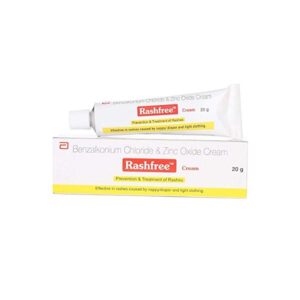ZINC OXIDE + BENZALKONIUM CL
Zinc Oxide: Zinc oxide is a medication that is primarily used as a topical ointment or cream to treat a variety of skin conditions. It is commonly used in the treatment of diaper rash, minor burns, and skin irritations. In addition, it is also used as a sunscreen to protect the skin from harmful ultraviolet (UV) rays.
The mechanism of action of zinc oxide is not fully understood, but it is believed to work by forming a protective barrier on the skin’s surface. This barrier helps to prevent excessive moisture loss, soothe irritated skin, and promote healing. As a sunscreen, zinc oxide works by reflecting and scattering UV rays, thereby reducing the risk of sunburn and skin damage.
Zinc oxide is available over-the-counter and can be found in various forms, including creams, ointments, lotions, and powders. The dosage and application method may vary depending on the specific product and the condition being treated. It is important to follow the instructions provided by the manufacturer or as directed by a healthcare professional.
In general, zinc oxide is considered safe for most people when used topically in the recommended doses. However, like any medication, it may cause some side effects. Common side effects of zinc oxide include skin irritation, itching, and a mild stinging or burning sensation. These side effects are usually mild and temporary.
In rare cases, some individuals may experience an allergic reaction to zinc oxide, characterized by rash, hives, swelling of the face, lips, tongue, or throat, difficulty breathing, or tightness in the chest. If any severe or persistent side effects occur, it is important to discontinue use immediately and seek medical attention.
It is worth noting that zinc oxide may interact with certain medications, such as tetracycline antibiotics and penicillamine, so it is important to inform your healthcare provider about any other medications you are taking before using zinc oxide.
Overall, zinc oxide is a widely used topical medication for various skin conditions, known for its protective and soothing properties. It is generally well-tolerated, but it is always advisable to consult with a healthcare professional before starting any new medication.
Benzalkonium Cl: Benzalkonium Chloride is a type of quaternary ammonium compound that is commonly used as a disinfectant and preservative in various medical, pharmaceutical, and household products. It is known by its chemical formula C21H38NCl.
Use: Benzalkonium Chloride is primarily used as an antiseptic and disinfectant. It is commonly found in hand sanitizers, ophthalmic solutions, nasal sprays, and wound cleansers. It is effective against a wide range of bacteria, viruses, fungi, and algae.
Mechanism of Action: Benzalkonium Chloride works by disrupting the cell membrane of microorganisms, leading to their destruction or inhibition of growth. It has both bactericidal (kills bacteria) and bacteriostatic (prevents bacterial growth) properties.
Dose: The concentration of Benzalkonium Chloride in products varies depending on the intended use. In hand sanitizers, it is usually present in concentrations ranging from 0.1% to 0.3%. For ophthalmic solutions, concentrations of 0.01% to 0.02% are typically used.
Side Effects: While generally considered safe when used as directed, Benzalkonium Chloride can cause skin irritation and allergic reactions in some individuals. Prolonged or repeated exposure to high concentrations can result in more severe skin reactions. In rare cases, it may cause eye irritation or damage if used inappropriately. It is important to follow the instructions and precautions provided with each product containing Benzalkonium Chloride.

